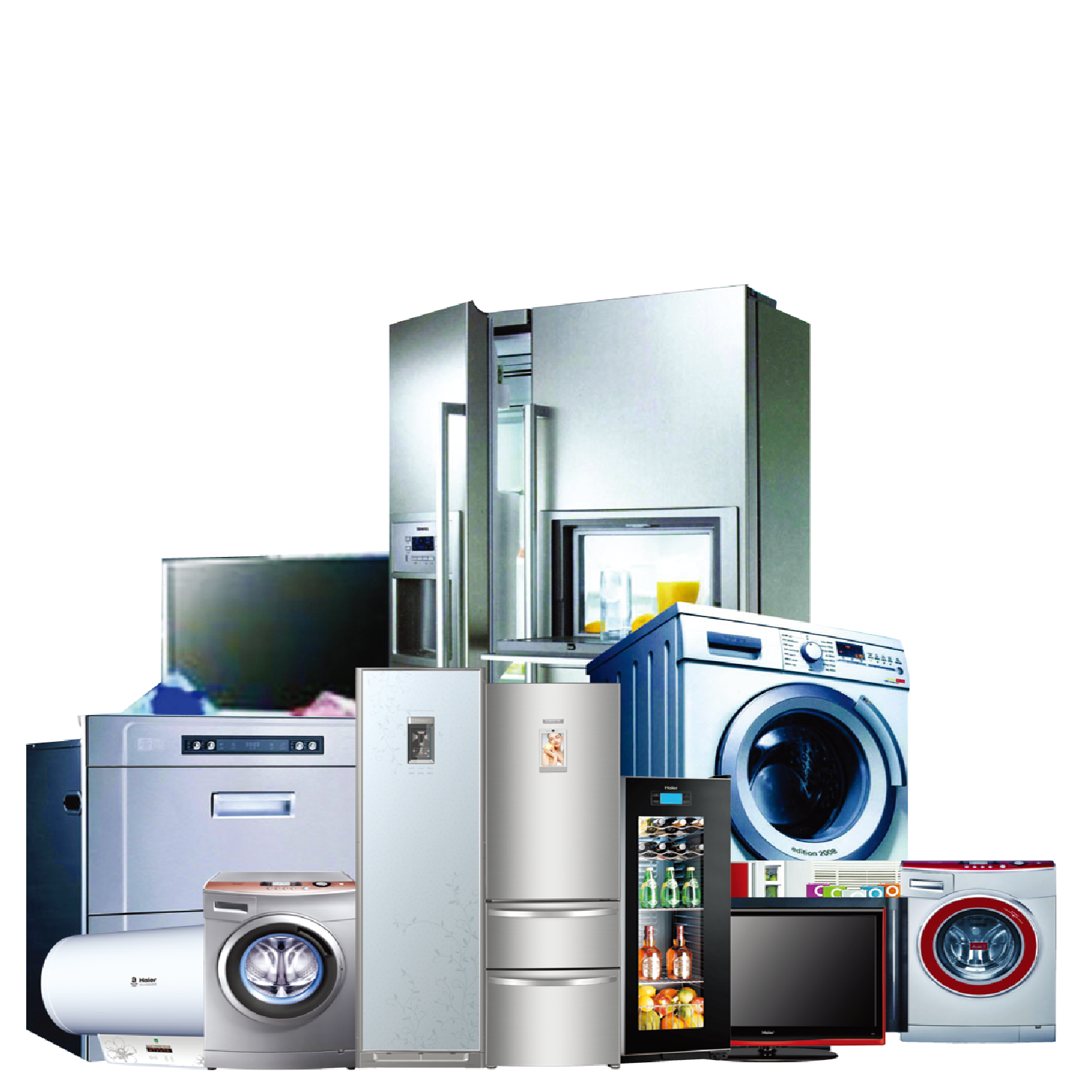⇡#Введение
Ни для кого не секрет, что к сегодняшнему дню развитие систем охлаждения для центральных процессоров практически сошло на нет. Всё, что можно было «выжать» из кулеров в установленных для них рамках теплораспределителей процессоров и габаритов компьютерных корпусов, уже выжато, а внедрять какие-то новые технологии производители пока не спешат. Поэтому в последние годы мы и становимся свидетелями выпуска слегка модернизированных кулеров, а то и вовсе перевыпуска прежних моделей под другими брендами и с другими названиями. К числу последних относится новый кулер компании IceHammer. Модель IH-4700, которая будет официально представлена со дня на день, является копией одного из прежних кулеров другой компании, но наделена современными креплениями и имеет весьма привлекательную стоимость. Но обо всём по порядку.
Packaging and Accessories
The cardboard box with the cooler and accessories features the same Thermalright’s traditional design. The cooler name is printed on one of the sides of the brown box:

While the exterior design of the Thermalright packaging could be improved towards something more user-friendly, then the reliability aspect of their packaging is pure perfection and they shouldn’t change a thing about it. Each component sits inside a special section of the polyurethane foam casing:
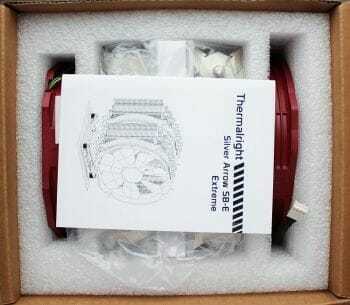
A little box inserted between the heatsink arrays contains retention kits. Among other accessories we should mention two fans, instruction manuals, thermal paste and Thermalright logo sticker for the system case:
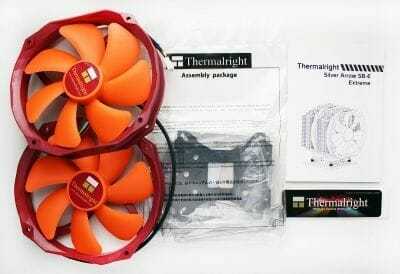
The cooler and fan retention kits are quite typical of Thermalright:
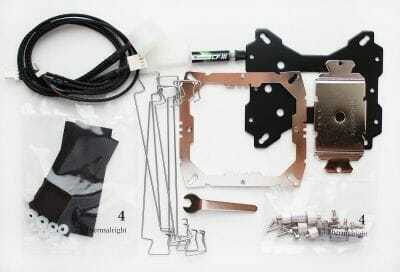
We can’t point out anything new in them.
SilverArrow SB-E Extreme is made in Taiwan and costs $90. It comes with a 2-year warranty.
Cooler Master Seidon 240M. Тайваньский Посейдон
О новинке известной тайваньской компании мы уже писали в одном из наших обзоров, поэтому вкратце напомним лишь об основных особенностях устройства.
Система состоит из двухслотового 240-мм радиатора с увеличенной площадью рассеивания. В комплекте идут два 120-мм «карлсона», на практике оказавшихся довольно шумными. В наборе поставки есть все необходимые крепления для монтажа системы на все современные платформы AMD и Intel, силиконовые прокладки для снижения вибрации и звукового давления, тюбик с термопастой, которого хватит как минимум на 5 установок.
Водоблок выполнен в классическом для данного типа устройств радиальном исполнении, к качеству обработки подошвы претензий у нас не возникло.
Packaging
Every CPU cooler I have received from Thermalright comes in a pretty nondescript plain brown cardboard box with just enough information to allow you to know you have the right box in your hands by seeing the Thermalright name and logo printed on the top of them.
On the right side of the box you see the Silver Arrow SB-E name and logo on the side, but with this version there is also the large X logo with the word Extreme pasted across it.
The left side is the only other part of the box with information on it. What is shown here is an inverse of the opposite side, if you are buying with a phone in hand; at least you have the web address so that you can look up the specs on this cooler.
Just taking a step back to show that Thermalright isn’t about wasting money on the packaging, and that I wasn’t skipping anything; the front, back, and bottom of this packaging is completely blank.
When you lift the front panel out and lift it and the top panel out of the way, you are greeted with the paperwork, a sticker, and a look at some foam and plastic.
Each of the 140mm fans are placed on either side of the cooler with the hardware box stuffed between the towers. There is a plastic liner over the body of the cooler, but to keep the components safe, Thermalright uses high density foam to isolate these and deliver a product that arrived in great shape.
SilverStone Heligon HE01
Heligon HE01 еще один представитель семейства супер-кулеров от компании SilverStone, который имеет двухсекционный радиатор, характерный всем современным кулерам этого класса. Первое что бросается в глаза это, конечно же, разная толщина секций радиатора. Конструкция радиатора Heligon HE01 схожа с той, которую используется в большинстве супер-кулерах. Шесть тепловых трубок распределяют тепловую энергию по двум секциям, на каждой их которых имеется по 47 алюминиевых пластин общей площадью порядка 10900 см2. Еще одна отличительная черта кулера, это наличие в комплекте массивного вентилятор типоразмера 140 мм с внушительной толщиной в 38 мм! Этот монстр способен обеспечить максимальный воздушный поток в 171 CFM со скоростью вращения 2000 об/мин, однако при этом шум от вентилятора назвать комфортным сложно.
Шестимиллиметровые тепловые трубки пронизывают небольшое по размерам основание кулера, которое имеет очень ровную поверхность. После обработки основания остались следы от фрезера, которые отчетливо видны и также тактильно ощущаются. Это конечно же может негативно повлиять на эффективность теплоотвода.
Рассмотрим основные характеристики SilverStone Heligon HE01.
| Габариты кулера, мм | 160 х 140 х 119 |
| Масса, гр. | 1150 (с вентилятором) |
| Материал основания | Никелированная медь |
| Материал ребер радиатора | Никелированный алюминий |
| Количество пластин, шт. | 47 х 2 |
| Материал тепловых трубок | Никелированная медь |
| Количество тепловых трубок шт. и диаметр мм. | 6 х 6 |
| Типоразмер вентилятора мм.,
их кол-во, шт. |
140х140х38
1 |
| Скорость вращения вентилятора, об/мин. | 500 – 2000 об/мин |
| Совместимость | Intel LGA 775/ 1155 / 1156/ 1366/ 2011
AMD Socket AM2/ AM2+/ AM3+/FM1/FM2 |
Performance
Cooling Efficiency
The results of our cooling efficiency tests are given on the following diagram and in the following table:
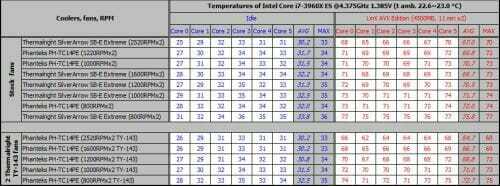
Thermalright SilverArrow SB-E Extreme in its default configuration does defeat Phanteks PH-TC14P? due to the high-speed cooling fans. Although it was achieved at a very high level of noise, as you probably understood already. AT lower rotation speed of its TY-143 fans, SilverArrow SB-E Extreme demonstrates no efficiency advantage over the competitor, and at 800 RPM is loses by 3°C. Moreover, if we use the same Thermalright fans on Phanteks PH-TC14P?, it will take the lead: it will be 2°C ahead of Thermalright at maximum fan speed, 4°C – at 1600 RPM, and after that 1-2°C ahead. Remarkably, Phanteks PH-TC14P? cooler with two TY-143 fans at 800 RPM is less effective than with its original fans.
After that we compared the coolers’ efficiency on a 4.5 GHz overclocked processor and at 1.435 V Vcore. The results are again summed up in the following table and diagram:

Again Thermalright SilverArrow SB-E Extreme outperforms Phanteks PH-TC14P? only due to high-speed cooling fans. And while Phanteks cooler ensures CPU stability in the entire rotation speed range, Thermalright struggles at 1200 RPM and lower speeds that is why you do not the results in this rotation speed range on the diagram. As for the results of Phanteks cooler with two TY-143 fans, the situation repeats: the tremendous airflow created by these fans helps Phanteks PH-TC14P? to defeat the Thermalright competitor by 3°C under peak load. If the fan speed is lowered to 800 RPM, Phanteks cooler also fails to maintain CPU stability (as we indicated by crossing out the maximum temperature value on the chart).
We will not add Thermalright SilverArrow SB-E Extreme results to our summary diagrams, because Thermalright SilverArrow SB-E is already there anyway, and its results are practically the same.
Acoustic Performance
We measured the noise level of our coolers throughout the entire speed range of their fans, as described in the chapter on testing methodology. Here are the results:

No wonder that Thermalright SilverArrow SB-E Extreme turned out much noisier than Phanteks PH-TC14P?. However, if we compare these two coolers at identical fan speeds, Thermalright will win. For example, two TY-143 fans on SilverArrow SB-E Extreme at 1550 RPM generate the same noise as two PH-F140TS fans on PH-TC14P? but only at 1280 RPM. Thermalright cooler also looks better at the subjective acoustic comfort threshold: 1000 RPM vs. 700 RPM, which is a substantial advantage in our opinion.
Final Thoughts
I have always liked the designs of dual tower coolers ever since I first laid eyes on the D-14. Ever since then there has been a massive surge to outdo that exact cooler. A lot of manufacturers brought solutions to the table, and while they may look better, most were equal to it in performance. The Silver Arrow SB-E was the first one like this that I really liked the unique design of, and it wasn’t the same old flat box with fans on it. I didn’t like the fans they included so much, the coolers were dark and dull, and didn’t demand any attention.
The Silver Arrow SB-E Extreme takes the design to a whole new level. Not only do these new colors demand your attention when looking into a PC, they aren’t all flash and no go like most other fans. There is no way you are going to hide the noise when delivering 12V to these fans, but the results showing that the 130 CFM of both fans is able to make this the best performing air cooler to date which we have tested here at TweakTown, and that speaks volumes for itself. Aesthetically and mechanically I have nothing to complain about nor was there anything that struck me as odd.
There are some downsides with this cooler, though. It does encroach on the memory, and that may be the one reason where you might need to pass on this cooler. For the devoted extremists out there, heat spreaders have never been an issue, and with the release of all the new low profile memory out there, there is at least ways to rectify this issue.
The other major thing that will keep a lot of the average builders from buying this cooler is the price. I know Thermalright demands top dollar for its coolers, and the near $100 price tag exemplifies this. Considering the coolers near it on the chart, the price is honestly reasonable. At the time I tested the three coolers better or slightly worse, they were all in this range as well. As for the air coolers on that list, not only is this one of the coolest looking CPU coolers I have ever had the pleasure of using, its coolness factor carries right through aesthetics and right into the lead.
In my opinion the Silver Arrow SB-E Extreme, despite the noise, is still worth every penny.
Noise Level Results
When the PC is at idle and the PWM has control of the fans, you really don’t hear much noise. Checking with AIDA64, the fans were only turning at 700 RPM and made slight jumps near 1000 if the heat did build up. This is how the SA SB-E Extreme is able to come in so low in the idle noise levels.
When the fans are let loose and spinning at 2523 RPM the noise levels jump exponentially. 69 decibels of noise is quite annoying for day to day running, but that noise comes with goodness. Even though these are some of the loudest 140mm fans I have ever used, there is no denying the temperature results that come with it.
Everything comes at a prices, and with this cooler, noise was not a concern when shooting for the stars.
Testbed Configuration and Testing Methodology
We tested all coolers inside a closed system case with the following configuration:
- Mainboard: Intel Siler DX79SI (Intel X79 Express, LGA 2011, BIOS 0537 from 07/23/2012);
- CPU: Intel Core i7-3960X Extreme Edition, 3.3 GHz, 1.2 V, 6 x 256 KB L2, 15 MB L3 (Sandy Bridge-E, C1, 32 nm);
- Thermal interface: ARCTIC MX-4;
- Graphics card: AMD Radeon HD 7770 1 GB GDDR5 128 bit, 1000/4500 MHz (with a passive copper heatsink from the DeepCool V4000 VGA cooler);
- System memory: DDR3 4 x 4GB Mushkin Redline (Spec: 2133 MHz / 9-11-10-28 / 1.65 V);
- System drive: Crucial m4 256 GB SSD;
- Drive for programs and games: Western Digital VelociRaptor (300GB, SATA-II, 10000 RPM, 16MB cache, NCQ) inside Scythe Quiet Drive 3.5” HDD silencer and cooler;
- Backup drive: Samsung Ecogreen F4 HD204UI (SATA-II, 2 TB, 5400 RPM, 32 MB, NCQ);
- System case: Antec Twelve Hundred (front panel: three Noiseblocker NB-Multiframe S-Series MF12-S2 fans at 1020 RPM; back panel: two Noiseblocker NB-BlackSilent PRO PL-1 fans at 1020 RPM; top panel: standard 200 mm fan at 400 RPM);
- Control and monitoring panel: Zalman ZM-MFC3;
- Power supply: Seasonic SS-1000XP Active PFC F3 1000 W (with a default 120 mm fan).
For the primary tests and summary diagrams we overclocked our six-core processor with the clock generator frequency set at 125 MHz, the multiplier at 34x and “Load-Line Calibration” enabled to 4.375 GHz. The nominal processor Vcore was increased to 1.385 V in the mainboard BIOS. After that we tested the new cooler at even higher frequency and voltage settings. Turbo Boost was disabled during this test session, and Hyper-Threading technology was enabled to increase the heat dissipation. The memory voltage was at 1.65 V and its frequency was 2000 MHz with 9-11-10-28 timings. All other parameters available in the mainboard BIOS and related to CPU or memory overclocking remained unchanged.
All tests were performed under Windows 7 Ultimate x64 SP1 operating system. We used the following software during our test session:
- LinX AVX Edition version 0.6.4 – to load the processor (memory – 4500 MB, Problem Size – 24234, two 11-minute cycles);
- Real Temp GT version 3.70 – to monitor the processor core temperatures;
- Intel Extreme Tuning Utility version 3.1.105.5 – for monitoring and visual control of all system parameters during overclocking.
So, the complete screenshot during the test session looks as follows:
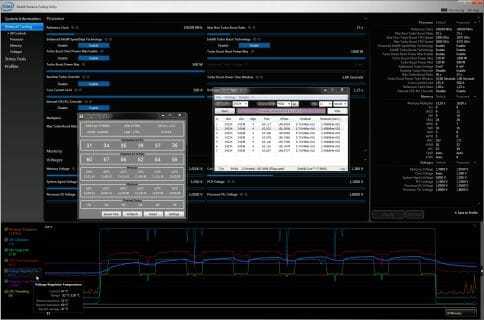
The CPU was loaded with two consecutive LinX AVX test runs with the settings as indicated above. The stabilization period for the CPU temperature between the two test cycles was about 8-10 minutes. We took the maximum temperature of the hottest CPU core for the results charts. Moreover, we will also provide a table with the temperature readings for all cores including their average values.
The ambient temperature was checked next to the system case with an electronic thermometer with 0.1 °C precision that allows hourly monitoring of the temperature changes over the past 6 hours. The room temperature during our test session varied between 22.6-23.0°C.
The noise level of each cooler was measured between 1:00 and 3:00 AM in a closed room about 20 m2 big using CENTER-321 electronic noise meter. The noise level for each cooler was tested outside the system case when the only noise sources in the lab were the cooler and its fan. The noise meter was installed on a tripod and was always at a 150 mm distance from the cooler fan rotor. The tested cooling systems were placed at the edge of the desk on a sheet of polyurethane foam. The lowest noise reading our noise meter device can register is 29.8 dBA and the subjectively comfortable noise level in these testing conditions was around 36 dBA (do not mix it up with low noise level). The fan(s) rotation speed was adjusted in the entire supported range using our in-house controller by changing the voltage with 0.5 V increment.
We are going to compare the cooling efficiency and noise levels of Thermalright SilverArrow SB-E Extreme against those of Phanteks PH-TC14PE with two default fans. The rotation speed of all fans was controlled using the same special controller I mentioned above with ±10 RPM precision.
Инструменты и методика тестирования
Конфигурация системы тестирования:
- Процессор: Intel i7-3930К (4.20 Ггц / НТon- 1.260в);
- Термоинтерфейс: Arctic Cooling MX-4;
- Материнская плата: ASUS Rampage IV Formula;
- ОЗУ: Corsair Dominator GT 2133MHz 4Gbx4;
- Видеокарта: ASUS HD7970 DC2 TOP;
- Блок питания: Corsair HX 650W.
Инструменты тестирования:
- Операционная система: Windows 7 x64;
- Программа мониторинга температуры ЦП: RealTemp GT 3.70;
- Программа для тестирования ЦП: LinX 0.6.4 AVX;
- Программа для ЦП:CPU-Z 1.62 x64;
- Реобас: Scythe Kaze Master II.
Частота процессора i7-3930К была увеличена до 4.2 ГГц при напряжении 1.260 В и активной технологиейHyper-Threading. С помощью программы LinX 0.6.4 AVX производилась 100% загрузка процессора в 10 тактов, общей продолжительностью ~10 минут. Замер температуры для каждого ядра осуществлялся при помощи программы RealTemp GT 3.70. Температурные значения, представленные ниже, являются среднеарифметическими для каждого режима. Кулеры тестировались в двух режимах со стандартными вентиляторами, которые входили в комплект поставки. Первый режим «тихий», скорость вращения вентиляторов составляла 1000-1050 об/мин, второй режим «максимальный», само название говорит о том, что скорость вращения вентиляторов была максимально возможная. Кулер Zalman FX100 Cube в пассивном режиме («тихий») и с установленным 90 мм вентилятором Arctic Cooling F9 при 1500 об/мин («максимальный»).Температура окружающей среды во время тестирования составляла 26о С.
Seite 1: Thermalright Silver Arrow SB-E Extreme im Test
Mit dem Thermalright Silver Arrow SB-E Extreme hat Thermalright eine spezielle Version des Silver Arrow auf den Markt gebracht, die besonders für Übertakter und Enthusiasten, die auch das letzte Quäntchen Leistung aus ihrer Kühlung und aus ihrem System herauskitzeln wollen, sehr interessant sein dürfte.
Nicht nur äußerlich unterscheidet der Silver Arrow SB-E Extreme nicht viel von seinem Vorgänger, denn der Kühlerkörper ist komplett identisch zum normalen Modell des Silver Arrow SB-E. Beide Kühler liegen im Twin-Tower Format vor. Jeweils acht 6-mm-Heatpipes durchlaufen die Lamellen des Kühlkörpers und transportieren somit die Wärme fort vom CPU und Sockel. Während Thermalright bei der normalen Version des Kühlers jeweils einmal den Thermalright TY-150 sowie den Thermalright TY-141 als Lüfter mitliefert, sind es bei der Extreme Version zwei Lüfter mit der Modellbezeichnung TY-143. Diese besitzen, laut Herstellerangaben, mit bis zu 2500 Umdrehungen pro Minute und einer Fördermenge von bis zu 217,1 m³/h eine deutlich höhere Leistung als die normalen TY-150 Lüfter. Die rot-orange, giftig anmutende, Färbung der Lüfter unterstreicht diese Ausrichtung auf maximale Leistung in sinniger Weise. Doch die Regelbarkeit zwischen 600-2500 Umdrehungen pro Minute macht den Kühler nicht nur für Enthusiasten interessant, da 600 Umdrehungen pro Minute durchaus auch eine sehr angenehme Akustik bedeuten können und somit den Silver Arrow SB-E Extreme nicht pauschal für silent-affine Nutzer disqualifizieren. Wie sich die Akustik der Lüfter in der Realität wirklich schlägt, wird dann die entsprechende Betrachtung der Lautstärke klären müssen. Laut Thermalright wurde der Kühlkörper weiterhin optimiert und speziell an die Lüfterform der Serienlüfter angepasst. Beiliegende Lüfterklammern erlauben, sollte dies vom Nutzer gewünscht werden, sogar noch die Montage eines dritten Lüfters. Doch die Herstellerangaben sowie eine erste Betrachtung des mächtigen Kühlkörpers lassen auf eine sehr potente Leistung schließen und hoffen – und machen den Silver Arrow SB-E Extreme somit auch zu einem interessanten Konkurrenten für kompakte AiO (All-in-One) Wasserkühlungen, die genau dann interessant werden, wenn normale Luftkühler an ihr Leistungslimit gelangen. Gerade da wir einige dieser AiO-Wasserkühler in der sehr nahen Zukunft testen werden, sind wir umso gespannter wie sich der Silver Arrow SB-E Extreme in unserem Testparcours so schlagen wird und ob es ihm gelingen wird sich als neue Referenz der Luftkühler zu positionieren und eine entsprechend hohe Hürde für die AiO-Wasserkühlungen zu setzen.

» Fotostrecke
Die direkte Konkurrenz, mit welcher sich der Silver Arrow SB-E Extreme messen muss, besteht weiterhin vor allem aus namenhaften Kühlern und Klassikern wie z.B. dem Noctua NH-D14 SE2011, Phanteks PH-TC14PE_BK sowie dem EKL Alpenföhn K2. Es sei erwähnt, dass unsere Testdatenbank seit dem Relaunch der CPU-Kühlertests deutlich größer geworden ist und das Testsystem nun Platz im neuen und großen NZXT Phantom 820 gefunden hat. Das neue Testsystem bietet somit für alle möglichen Kühler (inklusive größere AiO-Wasserkühlungen bis 280 mm) Platz und ist somit deutlich zukunftssicherer. Weitere Kühler in der Vergleichsdatenbank, und somit direkte Konkurrenten des Silver Arrow SB-E Extreme, sind normale Tower-Kühler wie der Akasa Venom, der Prolimatech Megahalems Black, der Arctic Cooling Freezer i30 oder auch der Alpenföhn Brocken 2. Außerdem wurden unlängst, auf Wunsch unserer Leser hin, der allseits beliebte Prolimatech Genesis sowie der Scythe Mugen 3 in unsere Vergleichsdatenbank aufgenommen.
Kompatibel ist der Silver Arrow SB-E Extreme zu allen aktuellen Intel- und AMD-Systemen. Bevor wir uns nun also einer näheren Detailbetrachtung widmen, hier noch der Thermalright Silver Arrow SB-E Extreme in der gewohnten Kurzübersicht:
| Kühlername | Thermalright Silver Arrow SB-E Extreme |
|---|---|
| Straßenpreis bei Release | 68,63 Euro (UVP: 69,99 Euro) |
| Homepage | http://www.thermalright.de |
| Maße | 14,7 cm (L) x 12,3 cm (B) x 16,0 cm (H) |
| Material | Kupfer (Bodenplatte und Heat-Pipes), Aluminium (Kühlrippen) Besonderheit: Vernickelter Kupferboden |
| Kühlertyp | Twin-Tower-Kühler |
| Serienbelüftung | 2x 140 mm Thermalright TY 143 PWM |
| Sockel | AMD: AM2, AM2+, AM3, AM3+, FM1, FM2 Intel: 775, 1150, 1155, 1156, 1366, 2011 |
| Gewicht | 1100 Gramm |
| Herstellergarantie | 2 Jahre |
Alle aktuellen Sockel werden unterstützt, auch der neuere Sockel 1150 für Intels Haswell-Prozessoren ist mit dabei.
<>Thermalright Silver Arrow SB-E Extreme im TestDetailbetrachtung Thermalright Silver Arrow SB-E Extreme
Вступление. Изучаем природу «воды» и «воздуха»
Для начала давайте немного обратимся к элементарной физике. Из теории известно, что коэффициент теплопроводности воды составляет 0,6 Вт/м*К, лишь немного уступая по этому показателю популярной в нашей стране термопасте КПТ-8 со значением 0,7 Вт/м*К. Воздух значительно отстает, и его коэффициент равен всего 0,026 Вт/м*К. Тогда почему СВО с таким же успехом не оказываются производительнее воздушных кулеров? Причина кроется в несовершенстве конструкции так называемых «водянок». Жидкость, циркулируя по замкнутой системе, нагревается, теряя тем самым в эффективности. К тому же тепло с нагретого радиатора «снимается» все тем же воздухом с помощью вентиляторов. Выходит, что без воздуха никуда не денешься! Вдобавок ко всему конструкция радиатора аналогично влияет и на качественный теплоотвод.
Еще одно слабое место «водянок» — помпа. Как вы знаете, в универсальных СВО этот элемент совмещен с «ватерблоком». Например, в NZXT Kraken X40, с которой вы познакомитесь в этом обзоре, водоблок имеет многоканальную структуру. Это хорошо с точки зрения грамотного отвода тепла от процессора, но такая система имеет повышенный коэффициент гидросопротивления, что подразумевает использование более мощных помп. Однако применить более производительный насос в ограниченной конструкции «замкнутых» СВО представляется очень сложной задачей. Инженерам приходится идти на компромиссы. Все же прогресс налицо: совершенствуются водоблоки, а вкупе с ними появляются все более мощные помпы.
Поэтому нет ничего удивительного в том, что универсальные системы водяного охлаждения при своих габаритах уже сравнялись со своими воздушными «коллегами» в производительности и уровню издаваемого при работе шума, сохраняя при этом вполне привлекательную стоимость. К тому же готовые системы теперь поддерживают все современные сокеты, следовательно, более податливы в процессе установки.
Похожие предметы
| Название |
| Bound Ice Storm Hammer (Скованный Молот Ледяной Бури) |
| Bound Ice Storm Hammer Focus (Скованный Молот Ледяной Бури) |
| Bound Ice Storm Hammer Anger (Скованный Молот Ледяной Бури) |
| Bound Ice Storm Hammer Critical Bleed (Скованный Молот Ледяной Бури) |
| Common Item — Ice Storm Hammer (Обычный Предмет – Молот Ледяной Бури) |
| Foundation Ice Storm Hammer (Хаотический Молот Ледяной Бури) |
| Ice Storm Hammer — Lightning (Молот Ледяной Бури — Гром) |
| Unidentified Ice Storm Hammer (Неопознанный Молот Ледяной Бури) |
| Ice Storm Hammer Focus (Молот Ледяной Бури) |
| Ice Storm Hammer Anger (Молот Ледяной Бури) |
| Ice Storm Hammer Critical Bleed (Молот Ледяной Бури) |
| Ice Storm Hammer — Lightning Focus (Молот Ледяной Бури — Гром) |
| Ice Storm Hammer — Lightning Anger (Молот Ледяной Бури — Гром) |
| Ice Storm Hammer — Lightning Critical Bleed (Молот Ледяной Бури — Гром) |
| Ice Storm Hammer Head (Навершие Молота Ледяной Бури) |
| Recipe: Ice Storm Hammer (100%) (Рецепт — Молот Ледяной Бури (100%)) |
| Recipe: Ice Storm Hammer (60%) (Рецепт — Молот Ледяной Бури (60%)) |
